As we stand at the forefront of an unprecedented era of growth, ARK Invest's "Big Ideas 2025" outlines the complex convergence of five continuously evolving technology-enabled innovation platforms of today: artificial intelligence, robotics, energy storage, public blockchains, and multiomics sequencing. These platforms are driving exponential progress across industries and catalyzing a leap change in global economic growth.
ARK Invest's 2025 report presents 11 Big Ideas that illustrate the massive transformations underway, which have the potential to dramatically improve productivity, disrupt industries, and create long-term investment opportunities with profound implications for investors, companies, and society at large.
In this regard, we have reviewed the sections in the 2025 report on AI Agents, Stablecoins, and Public Blockchains, presenting a perspective from the lens of a Wall Street fund on these issues. This vantage point allows us to move beyond the current PVP state of the crypto market and approach the true utility and future trends of innovative AI Agents, Stablecoins, and Public Blockchains in a more traditional and universal manner.
Take Aways:
AI Agents will change the logic of how people search and shop, and will be carried out by digital wallets;
Digital wallets can further integrate traditional banking financial services such as savings, lending, insurance, investment, and consumption, and through the AI Agent innovation paradigm, can move the value chain of downstream platforms' global e-commerce and digital consumption upstream;
Combining the utility of AI, the valuation of digital wallet companies will be enhanced. Importantly, digital wallets can not only cover the vast existing user base of Web2, but also form a value loop through AI Agents, and can seamlessly integrate with the innovative applications of Web3, bringing greater economic utility to users;
The annual transaction volume of has already approached the transaction volume of Visa and Mastercard, and its supply and the number of active addresses are expected to reach historic highs in 2024;
Innovations around based on blockchain will continue to emerge and become an important way to export the US dollar, and by 2030, the market capitalization of may grow to $14 trillion;
In this field, with the continuous improvement of innovative financial infrastructure and the integration with traditional financial infrastructure, coupled with the support of AI, there will certainly be more investment and mergers and acquisitions from the traditional financial perspective.
I. Five Innovation Platforms Accelerating Economic Growth
The changes in macroeconomic growth are in line with historical patterns. Human history has been stagnant for 100,000 years, but innovation (especially writing) has enabled empires to connect all continents, doubling the actual growth rate by 1000 AD. Subsequently, agricultural innovations led to increased population density and labor specialization, causing the growth rate to double again to 0.3% by 1500.
In the 400 years before 1900, as the Enlightenment and the Industrial Revolution swept the globe, the annual GDP growth rate doubled again to 0.6%. Thereafter, the Second Industrial Revolution, marked by electrification, automobiles, and telephones, ushered in modernization and has increased the growth rate fivefold to an average of 3% over the past 125 years.
Today, breakthroughs in artificial intelligence and smart robotics may again boost productivity and drive the next step change in economic growth over the next 5 to 10 years. By 2030, ARK Invest expects the growth rate to reach 7.3%, compared to the IMF's 3.1%.

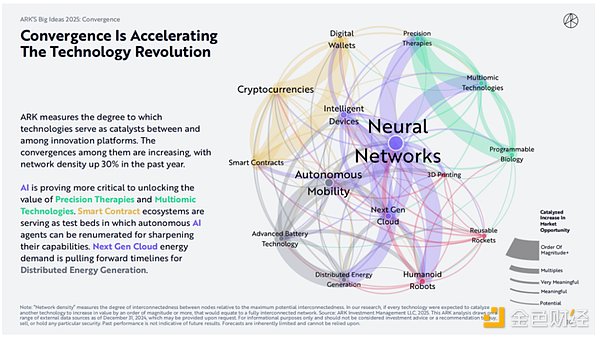
Against this backdrop, the convergence of multiple technology platforms, including and , is increasing, with network density growing 30% over the past year.
Public Blockchains
After widespread adoption, all currencies and contracts may migrate to , enabling the verification of the scarcity and ownership of digital assets. The traditional financial system may reconfigure assets to accommodate the rise of cryptocurrencies and smart contracts. These technologies increase transparency, reduce the impact of capital and regulatory control, and lower contract execution costs.
In such a world, as more assets become more easily monetized, and as businesses and consumers gradually adapt to the new financial infrastructure, the digital wallets that hold everyone's assets will become increasingly important.
AI
With the development of data, computing systems and software can solve complex problems, automate knowledge work, and accelerate the integration of technology into every economic sector. The adoption of should be more significant than electrification and could create tens of trillions of dollars in value. In terms of scale, these systems will require unprecedented computing resources, and -specific computing hardware will dominate the next generation of cloud data centers that train and operate models.
The potential for end-users is evident: -driven smart device fleets will permeate people's lives, changing the way they consume, work, and entertain. The adoption of should transform every industry, impact every business, and catalyze every innovation platform.
II. AI Agents Redefining Consumer Interactions and Enterprise Workflows

understand intent through natural language, use reasoning and appropriate context for planning, take action using tools to achieve intent, and improve through iteration and continuous learning. As more intelligent models emerge, will use more and more complex tools to accomplish higher-value tasks.
AI Agents will accelerate the adoption of more digital applications and bring a paradigm-shifting change in human-machine interaction. Whether in hardware sales or software subscriptions, the combination of will drive the large-scale application of . For example, embedding in the operating systems of consumer hardware will allow consumers to delegate all discovery and research to , saving them a significant amount of time.
2.1 AI Agents Will Change the Logic of How People Search and Shop

may become the entry point for personal search, and if search shifts to personal , their advertising revenue could soar. By 2030, ARK Invest believes that advertising revenue could account for more than 54% of the $1.1 trillion digital advertising market, directly capturing market share from traditional search giants like Google.
Digital Advertising. Carefully curated feedback results will create opportunities for digital advertising. If the search business shifts to personal , their advertising revenue could soar. ARK Invest believes that by 2030, advertising revenue could account for more than 54% of the $1.1 trillion digital advertising market.
Online Consumption. By 2030, ' shopping volume could approach 25% of the global addressable online shopping base. Consumers using for shopping will simplify product discovery, provide personalized solutions, and facilitate convenient purchasing. ARK Invest's research indicates that by 2030, could drive nearly $9 trillion in global online consumption.
2.2 Digital Wallets Will Help AI Agents Achieve Value Loops
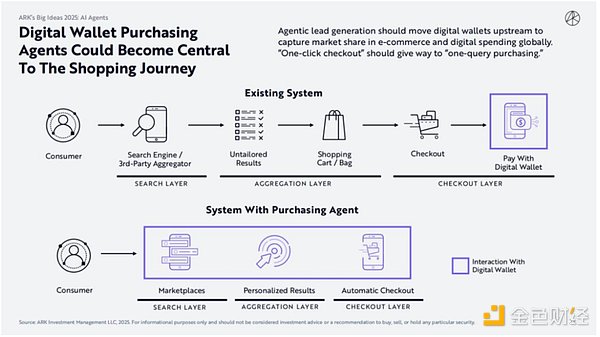
ARK Invest's research suggests that authorized by will capture share from traditional payment methods like credit and debit cards, potentially accounting for 72% of all e-commerce transactions by 2030. are integrating financial services and e-commerce. Based on their consumer-facing business, the market values leading platforms like , , and at $1,800 per user.
Here is the English translation of the text, with the specified terms retained and not translated:In addition to digital wallets being able to integrate traditional banking and financial services such as savings, lending, insurance, investment, and consumption, with the help of the AI Agent innovation paradigm, digital wallets can take on the value chain of global e-commerce and digital consumption on downstream platforms, thereby moving the value chain upstream.
Thus, the "one-click checkout" model of e-commerce platforms like Amazon may give way to the "one-time query and purchase" model of AI Agent wallets.

2.3 The valuation of digital wallet companies will be enhanced
Based on the potential customer generation rate and the impact of the AI Agent innovation paradigm, by 2030, AI Agent can create global revenue of $40 billion to $200 billion for digital wallet platforms (respectively for ARK's base case and optimistic case). By 2030, AI Agent can add $50 to $200 in enterprise value (EV) per user of US digital wallets.
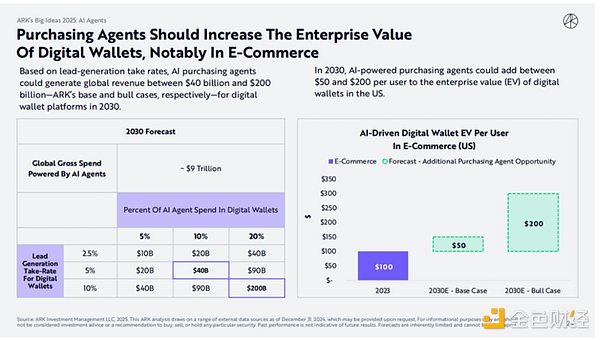
In terms of internal cost reduction and efficiency improvement, companies that deploy AI Agent should be able to increase unit volume and/or optimize the workforce to engage in higher-value activities while maintaining the same labor force. As artificial intelligence advances, AI Agent may handle a higher proportion of workload and independently complete higher-value tasks.
Meanwhile, as AI costs decline, more low-cost, high-efficiency AI Agent products will emerge. OpenAI and Salesforce's new products are complementing human customer service representatives in an economically efficient way. Even if the fixed cost per conversation is $1, as long as the AI agent can handle 35% of customer service inquiries, it can save companies a significant amount of money. AI agents should also reduce onboarding and recruitment costs as well as seat-based software costs, and are more scalable than human labor.
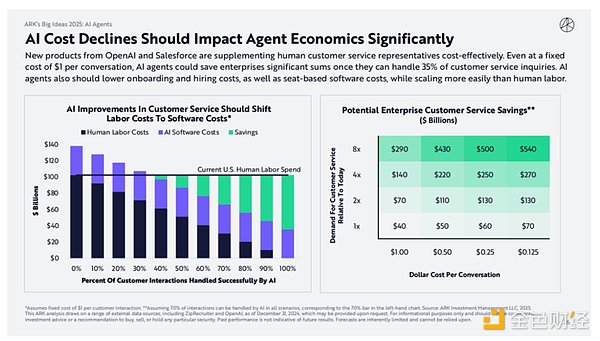
III. Stablecoins Reshaping the Digital Asset Realm

As one of the fastest-growing areas in digital assets, stablecoins' trading volume will exceed Mastercard and Visa in 2024. Despite a two-year bear market that saw their market capitalization drop by more than 70%, the growth of stablecoins has not been interrupted.

3.1 Stablecoin trading volume is already approaching Visa and Mastercard
According to ARK Invest's report, in 2024, the annualized trading volume of stablecoins will reach $15.6 trillion, which is about 119% and 200% of Visa and Mastercard, respectively. The monthly transaction volume will reach 110 million, accounting for 0.41% and 0.72% of the transaction volume processed by Visa and Mastercard, respectively. In other words, the value per stablecoin transaction is much higher than Visa and Mastercard.

(visaonchainanalytics.com/transactions)
Due to the various use cases of stablecoins, transactions can be manually initiated by end-users or programmatically initiated by bots, resulting in a significant amount of noise in stablecoin data. Therefore, Visa adjusts the stablecoin data to remove the non-organic activities and other artificial inflationary behaviors adapted by bots.
According to Visa Onchain Analytics Dashboard: Overview, the adjusted annualized stablecoin trading volume in 2024 will reach $5.62 trillion. We analyze the data for the 12 months ending February 2025:
Raw data:
Annualized stablecoin trading volume is $32.3 trillion, with a total of 4.9 billion transactions, and an average transaction value of $6,592. Corresponding to a total stablecoin supply of 200 billion, the velocity is 161.5.
Adjusted data (excluding bot operations and high-frequency behaviors):
Annualized stablecoin trading volume is $6.1 trillion, with a total of 1.3 billion transactions, and an average transaction value of $4,692. Corresponding to a total stablecoin supply of 200 billion, the velocity is 30.5.
Therefore, according to Visa's data, the adjusted stablecoin trading volume is already approaching the annual transaction volume of Mastercard, and the value per transaction is even higher.
(If there are any errors in the data or other data statistical calibers, please feel free to discuss and correct them.)
3.2 Stablecoin supply and active stablecoin addresses will reach new highs in 2024
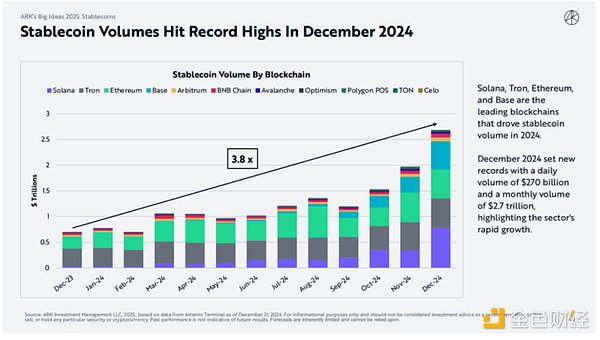
Although there are differences in data statistics, the overall stablecoin market capitalization has already exceeded $200 billion and is maintaining a continuous upward trend. Solana, TRON, Ethereum, and Base are the leading blockchains driving the growth of stablecoin trading volume in 2024. December 2024 set a new record, with a daily trading volume of $270 billion and a monthly trading volume of $2.7 trillion, highlighting the rapid growth of the industry.
After the decline in 2023, USDT (Tether) continues to dominate the stablecoin sector, followed by USDC (Circle). Together, they account for 90% of the total supply. Multi-chain stablecoins have penetrated almost all major L1 blockchains. The current stablecoin supply is $203 billion, accounting for about 0.97% of the US M2* money supply. In December 2024, the number of active stablecoin addresses reached a historic high of 23 million. Measured by monthly active addresses, TRON is the leading network, favored by emerging markets due to its low transaction fees.
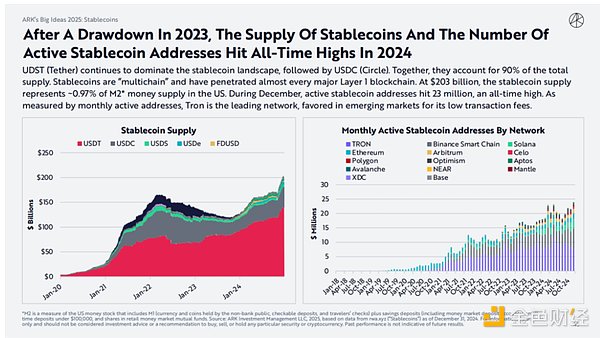
L2 blockchains with lower costs and higher efficiency are attracting the interest of retail investors. Retail investors are flocking to Layer 2 to conduct cheaper and more convenient stablecoin transactions, increasing the market share of blockchains like Arbitrum, Base, and Optimism. Meanwhile, whales and institutions continue to operate on the Ethereum base layer. Transactions under $100 are dominated on Base and Optimism, while transactions over $100 are dominated on the Ethereum base layer.
3.3 Peer-to-peer transactions and personal wallet storage dominate stablecoin use cases
EOA wallets - the standard Ethereum addresses used for peer-to-peer (P2P) transactions and asset storage - account for 60% of USDC usage, while centralized exchanges account for 11%, cross-chain bridges and L2 solutions account for 7%, and decentralized exchanges (DEXs) and money markets each account for 1.7%.
As DeFi usage explodes in the coming years, DEXs, cross-chain bridges, and money markets may regain market share from P2P. While the usage of lending markets, DEXs, and cross-chain bridges fluctuates with market cycles, P2P transactions and storage are more resilient, as the product-market fit is higher beyond just trading.
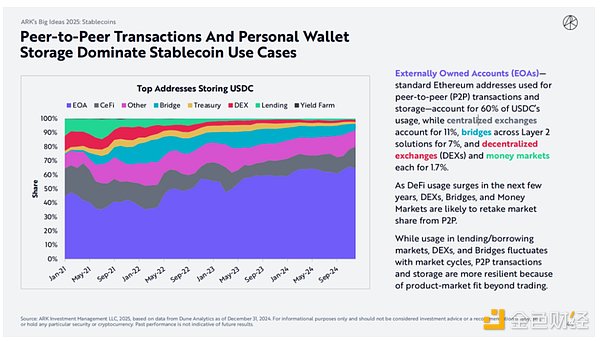
3.4 Four stablecoin issuers dominate stablecoin revenue
Tether, with fewer than 200 employees, is reported to have generated $5.2 billion in profits in the first half of 2024, including USDT, its other products and services, and unrealized gains on its digital assets - clearly one of the most capital-efficient businesses in history. Tether (USDT) and Circle (USDC) account for 60% of the top five networks and applications generating revenue. Overall, the stablecoins USDT, USDC, DAI/USDS, and USDE generated $3.35 billion in revenue in the second half of 2024, annualizing to $6.7 billion.
Here is the English translation:
Circle and Tether have been generating billions of dollars in revenue by using Treasury bills and other securities as collateral for their stablecoins. However, in 2024, in order to compete and meet demand, yield-bearing stablecoins operating outside the US will start passing a significant portion of their interest income to users. Unless absolutely necessary, Circle and Tether are unlikely to follow this trend. Although still small in scale, yield-bearing stablecoins are the fastest growing category in the stablecoin market.
3.5 Stablecoins will accelerate growth and absorb US Treasuries
To balance "de-dollarization", stablecoins are increasing their demand for US government debt as collateral. In a world moving towards deglobalization and de-dollarization, stablecoins may drive stable demand for US Treasuries. As of December 2024, Tether and Circle have collectively become the 20th largest holders of US Treasuries. In populous emerging markets such as Brazil, Nigeria, Turkey, Indonesia and India, individuals and companies are adopting stablecoins as a store of value, means of payment and cross-border currency. Stablecoins may become one of the most effective ways to export the US dollar.

The current market capitalization of stablecoins is $203 billion, accounting for 0.17% of the global M2** supply. By 2030, the market capitalization of stablecoins may grow to $1.4 trillion and 0.9% respectively. If so, stablecoins will become the 13th largest currency in circulation, behind Spain and ahead of the Netherlands.
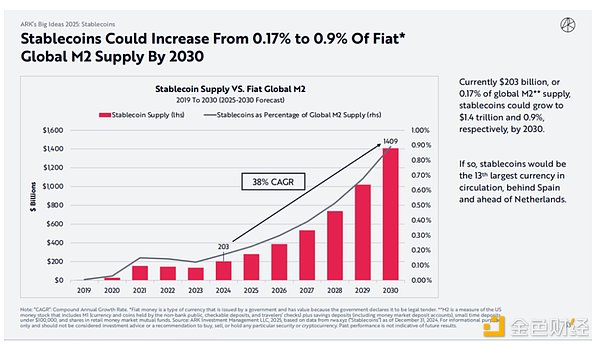
IV. Public Blockchains and Smart Contracts: Achieving Cost Reduction and Creating New Use Cases at the Application Layer
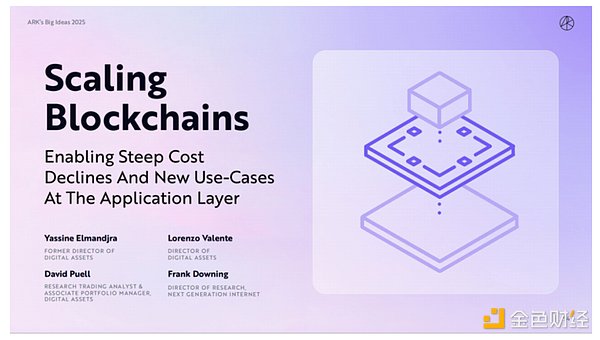
As the digital asset space becomes increasingly complex, smart contracts are driving innovation across more and more industries. The ecosystem is rapidly evolving to meet diverse and dynamic needs - from user-centric applications like games and SocialFi, to advanced financial tools like derivatives and structured products, to decentralized infrastructure networks supporting wireless connectivity and energy storage.
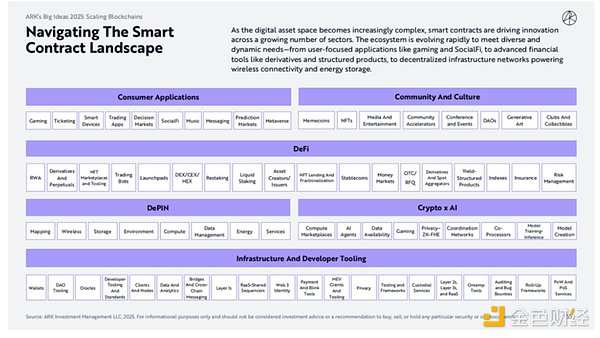
All these technology stacks require seeking a lower-cost and more efficient Blockchain for deployment. This has led to the current market landscape, with deployments either on the high-throughput L1 of Solana, or on the L2 of Ethereum.
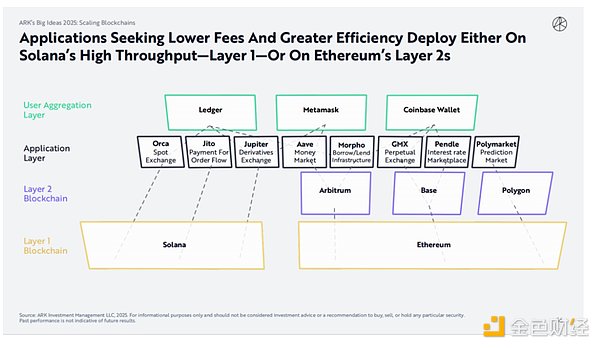
4.1 The Ethereum Ecosystem is Shifting to L2
The significant reduction in transaction costs has led to a surge in L2 activity, drawing users away from Ethereum's base layer. L2 accounts for 85% of the daily active addresses transacting within the Ethereum ecosystem. L2 activity has increased Ethereum's daily transaction volume from 3 million to 15 million, a 400% increase, by 2024.

Among them, Base is the fastest growing Ethereum L2 Blockchain. Within a year of launch, Base has surpassed all other Ethereum L2 solutions in terms of growth and market share. In 2024, Base accounts for 46% of active users and generates 63% of fees on Ethereum L2. Base has a TVL of $15 billion, has deployed over 300 applications, and has made a significant contribution to Coinbase's cash flow.
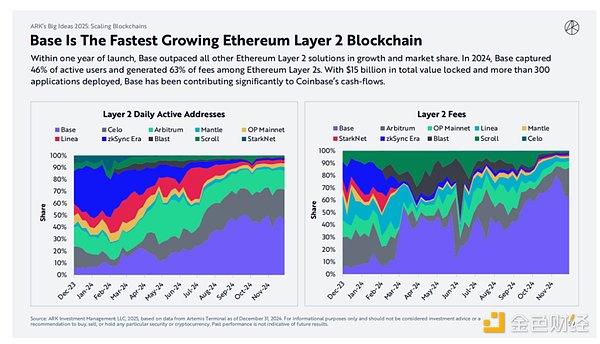
Nevertheless, Ethereum's base layer still dominates high-value storage and settlement. Institutions, high-value users, and whales primarily settle their transactions on the Ethereum base layer. In terms of total locked value (TVL) and decentralized exchange (DEX) volume per user, the unit economics of the Ethereum base layer are unparalleled.
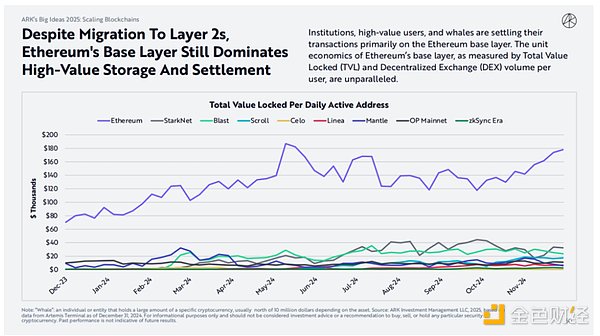
4.2 Solana's Share Has Gained Traction Across Multiple Metrics Due to Retail Adoption
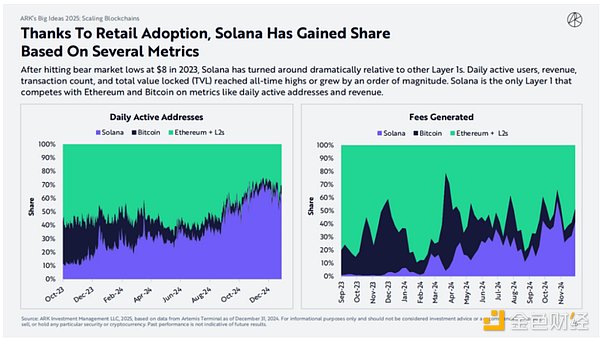
After reaching an $8 bear market low in 2023, Solana has seen a significant improvement relative to other L1s. Daily active users, revenue, transaction volume, and total locked value (TVL) have all reached historic highs or grown by an order of magnitude. Solana is the only L1 that competes with Ethereum and Bit in metrics such as daily active addresses and revenue.
Solana and Base are leading in developer adoption and mindshare. Of the 39,139 new crypto developers added in 2024, Solana led with 7,625 developers, surpassing the Ethereum mainnet. Base has 4,287 developers, ranking 6th overall, surpassing Arbitrum and Starknet to become the leading Ethereum L2 solution.








